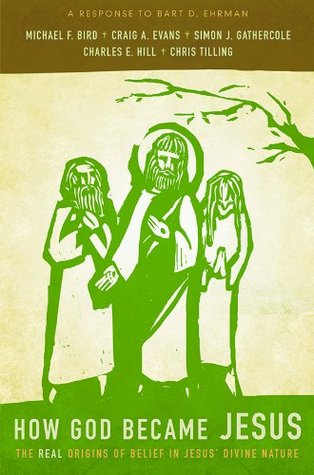More on this book
Kindle Notes & Highlights
The only way to make this say that the majority of Christians are modalists would be to try to make a syllogism out of it: the simple are modalists; most believers are simple; therefore, most believers are modalists. But this only works if there is another hidden element: not just “the simple are modalists” but “all the simple are modalists.”
Tertullian’s larger account in his treatise against Praxeas indicates that the swelling number of modalists was a brand new thing. Praxeas, according to Tertullian, was the person who brought these ideas to Rome from Asia, but he had actually recanted his views. For some time, then, these views remained dormant until they recently had sprung up again (Against Praxeas 1). Now, it is always possible that Tertullian is stretching the truth or even telling a flat-out lie. But the fact remains that we have no positive evidence for modalism being the majority view even in Rome, let alone in the
...more
The bottom line here is that from neither of these writers are we able to conclude that modalism was the majority view even of Christians in Rome, let alone in every place throughout the empire.
THE BISHOP: IGNATIUS OF ANTIOCH I bid you farewell always in our God Jesus Christ; may you remain in him, in the unity and care of God. I greet Alce, a name very dear to me. Farewell in the Lord. (Ignatius, To Polycarp 8.3, trans. M. Holmes). Ignatius was the bishop of Syrian Antioch (died ca. 110 CE). He wrote a series of letters to several churches while being escorted to Rome en route to his execution. In these letters he makes several striking affirmations about Jesus as God and intimately related to the Father. In some cases, the language seems liturgical, hymnic, and overtures later
...more
angel.” For some reason, however, Ehrman translates theos as “divine being” rather than “God.”
Hurtado points out that in the earliest observable stage of Christian scribal activity, four words in particular were written as nomina sacra with great regularity: God, Lord, Christ, and Jesus.
These abbreviations were used almost universally in the early church. Nomina sacra contractions of the name of Jesus appear not only in early Christian manuscripts, but they have been discovered in a third-century floor mosaic at Megiddo in Palestine and in a third-century wall painting in a house church at Dura Europa on the banks of the Euphrates River.
It is easy for the reader to get the impression that this chronology is a rational “conclusion” of unbiased historical study — instead of what it actually is, a presupposition of historical study — because of the way in which Ehrman presents the evidence.
There is nothing explicit here about Jesus’ preexistence or his full deity. True, it is surely assumed in the meaning of the words “his only Son” in the first line. But according to Ehrman, such a bare statement could just as well mean that Jesus was exalted to Son of God status at his baptism or resurrection, perhaps even at his conception.
Creeds are always mere summations of what believers believe; the rest is assumed to be filled in by teaching and preaching and is usually commonly known in the community.
Now we see that we cannot establish that the earliest Christians believed Christ was a mere man exalted to deity only at his resurrection (or his baptism). Such a view, if it ever existed, cannot be shown to be any earlier than a view that recognized Jesus’ preexistent deity.
doctrine. But what Ehrman calls their “ortho-paradoxes” are what they celebrated, not what they tried to cover up and hide from view. And what they were celebrating had been celebrated in their Christian communities for a long time.
The reason Ehrman’s presentation is misleading is that for Justin, Christ, the Logos, is begotten of the Father, and Justin makes a clear distinction between what is begotten of God and what is “created.” As Kelly summarizes, for Justin, “while other beings are ‘things made’ (poiēmata) or ‘creatures’ (ktismata), the Logos is God’s ‘offspring’ (gennēma), His ‘child’ (teknon) and ‘unique Son’ (ho monogenēs): ‘before all creatures God begat, in the beginning, a rational power out of Himself.’ ”18 Justin is emphatic on the distinction between being begotten and being created. Christ is not “a kind
...more
But this reading is suspect. Not only would it go against all prior (and subsequent) prohibitions against worshiping angels, such as Col 2:18 or Rev 19:10; 22:8 – 9, but Justin himself clearly says God created the “race of angels” in the beginning along with the race of men (1 Apology 7.5).
about the ineffable God they worshiped. Trinitarian theology especially from the time of Tertullian, but using terminology formulated at least as early as Justin, speaks of three divine “persons” (Greek prosōpon; Latin persona), rather than divine beings.
So in these [texts], few though they be, yet the distinctiveness of the Trinity is clearly expounded:
“The God-loving Akeptous has offered the table to God Jesus Christ as a memorial.” Evidently a woman named Akeptous donated the table for use in the Christian community, and the inscription commemorates her generosity as a benefactor to the church. The words “offered” and “memorial,” as well as “God Jesus Christ,” are sure signs that Jesus is recognized as a divine figure worthy of receiving religious devotion normally appropriate for Israel’s God.
Lastly, while there has been a horrid history of Christian anti-Judaism, it wrong to say that its immediate cause was belief in the deity of Christ.


